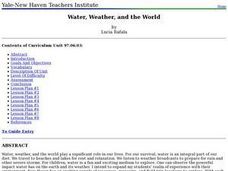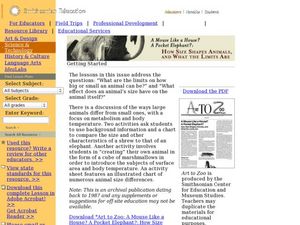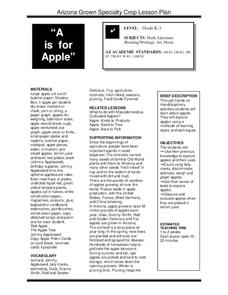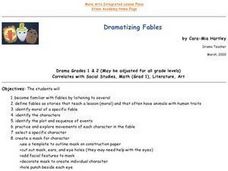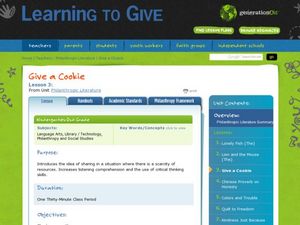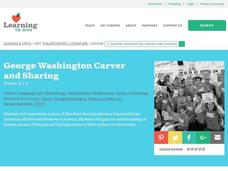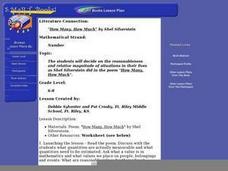Curated OER
Presidential Trading Cards
Learners research the Internet to collect data about the US Presidents. They use the data that they collect along with available technology to produce trading cards and brochures using keyboarding skills, text boxes, acquiring photos,...
Curated OER
Water, Weather, and the World
Students in a special education classroom examine the role of weather and water in their lives. Each day, they add a symbol for the weather outside and identify the proper activities for the weather on that day. In groups, they...
Curated OER
How Size Shapes Animals
Students investigate how size affects large and small animals differently. In this animal lesson plan, students determine how size affects different animals by constructing their own animal out of marshmallows. Once students create...
Curated OER
Neighborhoods
Students examine homes around the world. In this multicultural lesson, students read the book A World of Homes and Homes Around the World. Students compare and contrast the homes in the books to their own homes. Students construct a...
Curated OER
Rocks and Minerals
Students bring rocks and minerals from home to investigate in the classroom. In this rocks and minerals lesson plan, students observe all the rocks and minerals brought into the class and answer 7 questions about the features of the...
Curated OER
Poetry and Our National Anthem
Students express the meaning of the Star-Spangled Banner. In this American history lesson, students read through the national anthem and complete an activities from a list of choices. Some choices include: writing the anthem in your own...
Curated OER
Snowflake Crystals
Fourth graders explore physical changes and the true life story of Wilson Bentley. They observe the changes that take place with snowflakes. Students discuss what happens when snow flakes melt. They create their own snowflakes using...
Curated OER
Buggy Patterns
First graders discuss the definition of patterns, and sing the song, Going Buggy, identifying patterns in the song. They create original patterns using bug counters and insect stickers.
Curated OER
A is for Apple
Students participate in a variety of activities to learn about apples. Students graph apples, learn about apple uses, taste apples, and observe what happens when apples are dipped in lemon juice.
Curated OER
Dramatizing Fables
Students familiarize themselves with fables by listening to several of them. They define fables. They identify the moral of a specific fable. They identify characters, plot and sequence of events. They create a mask of a character in a...
Curated OER
Let's Learn About Jobs
Students evaluate the jobs that their parents do. In this literature-based social studies lesson, the teacher introduces the concept of work both at home and on the job and leads the children in the creation of a Venn diagram to aid in...
Curated OER
Give a Cookie
Students discover the importance of sharing. In this philanthropy lesson, students read the book The Doorbell Rang and discuss how the character practiced sharing in the story. Students make cookies and practice the philanthropic concept...
Curated OER
George Washington Carver and Sharing
Young scholars research George Washington Carver. In this science lesson, students discuss George Washington Carver's contribution to science. Young scholars explain how peanut butter is produced.
Curated OER
"Is There Room on the Bus?" by Helen Piers
Middle schoolers express answers as fractions, decimals, and percents.
Curated OER
Geo Jammin'-Day2, Lesson 7: Roll, Roll, Unroll the Scroll
Second graders write in journals, recording personal thoughts about what they learned and/or something they are wondering about.
Curated OER
"The King's Chessboard" by David Birch
Learners determine how a counting pattern is created is the story. They estimate how much rice is given to the wise man.
Curated OER
"A Closet Full of Shoes" and Picture Puzzle Piece" by Shel Silverstein
Students explain the concept of simple probability.
Curated OER
"The Patchwork Quilt" by Valerie Flournoy pictures by Jerry Pinkney
Students recognize squares and find a pattern for counting squares.
Curated OER
"The Rajah's Rice: A Mathematical Folktale from India" adapted by David Barry
Learners use large numbers and learn exponential representation and explain patterns and relations of powers of 2.
Curated OER
"YIKES! Your Body Up Close" by Mike Janulewicz
Students use a Venn Diagram to analyze data from their class.
Curated OER
Geo Jammin' - Day 4, Lesson 15: Geo Jingo Jivin'
Second graders explore how musical instruments h ave varying geometric shape, and how those geometric shapes correspond to three-dimenaional shapes that students have studied.
Curated OER
"Anno's Mysterious Multiplying Jar" by Masaichiro and Mitsumasa Anno
Students learn the meaning of the word "factorial" and how to apply the factorial concept to describe a special kind of numerical relationship.
Curated OER
"How Many, How Much" by Shel Silverstein
Middle schoolers decide on the reasonableness and relative magnitude of situations in their lives as Shel Silverstein did in the poem "How Many, How Much."
Curated OER
"Alexander, Who Used to Be Rich Last Sunday" by Judith Viorst
Students figure out the probability that the penny's sixth toss be heads also. They figure the probability of having six coin tosses in a row all end on the same side.

